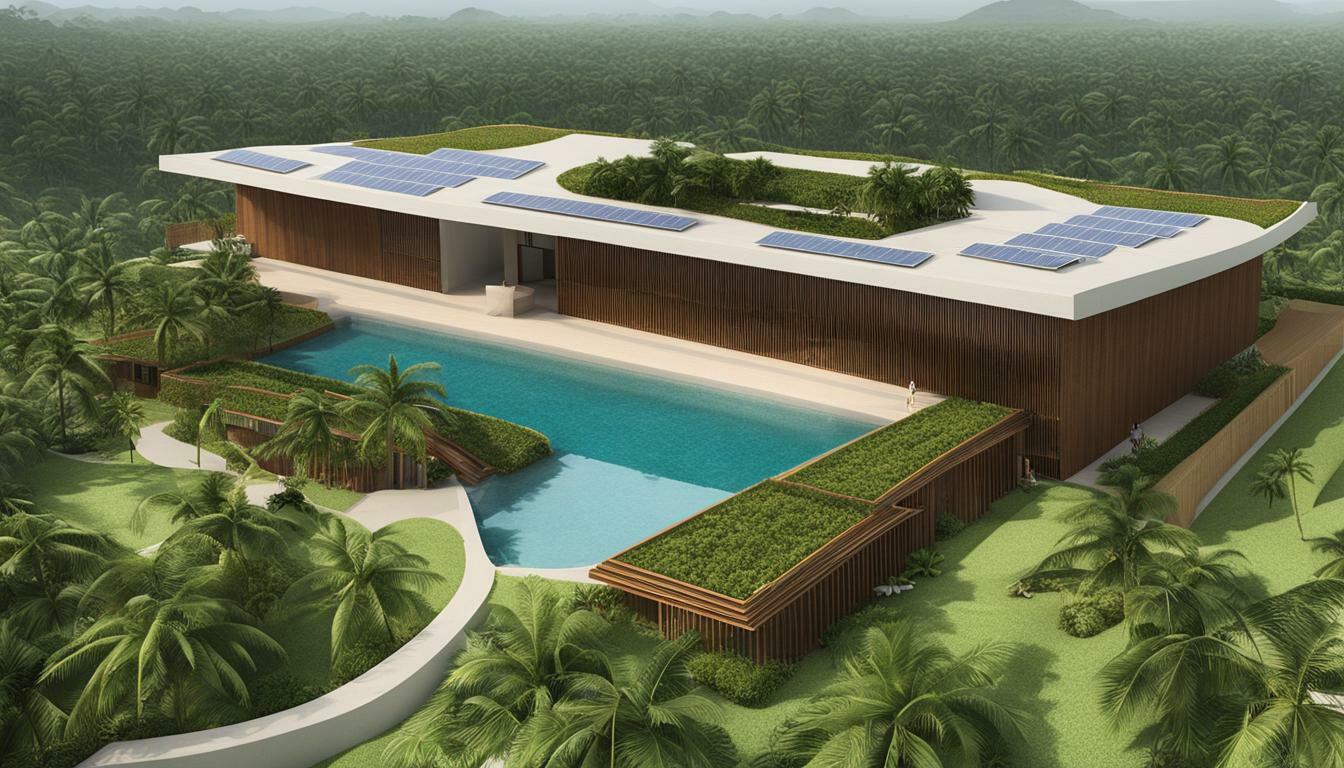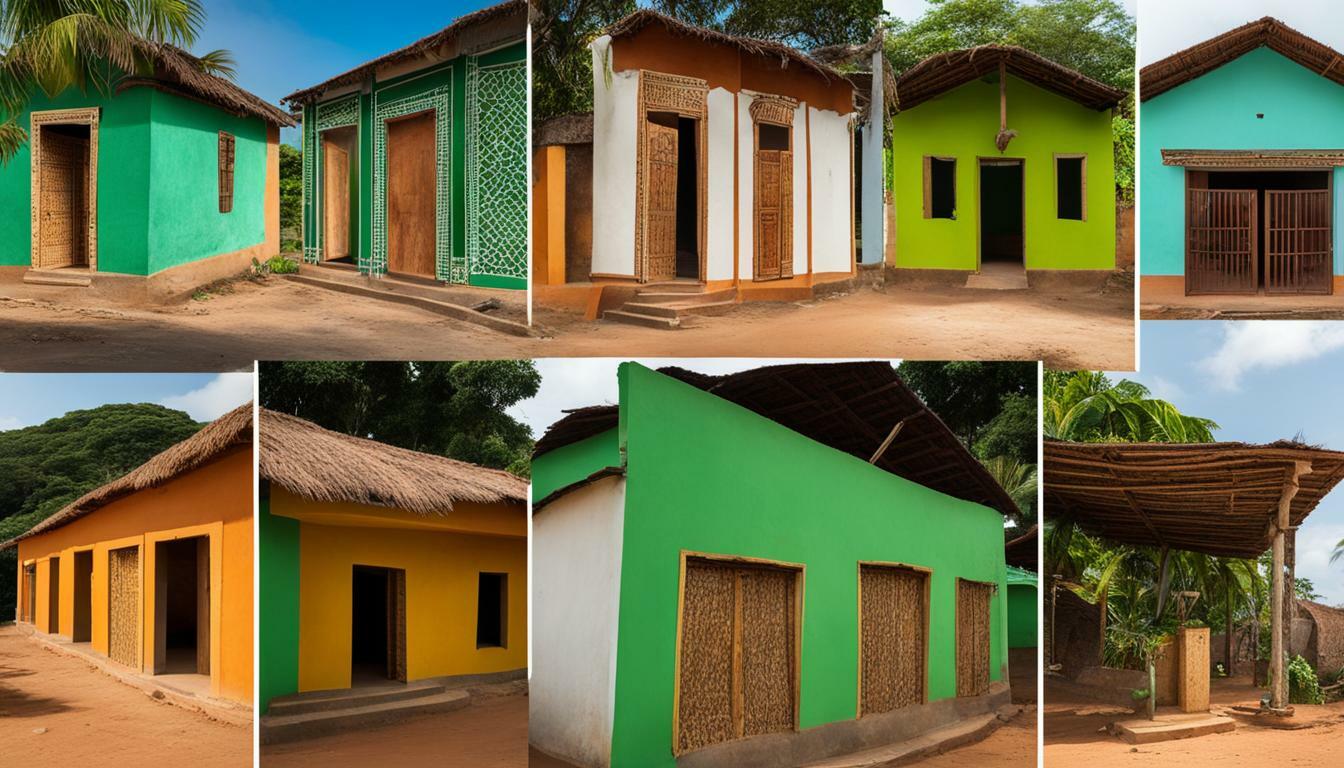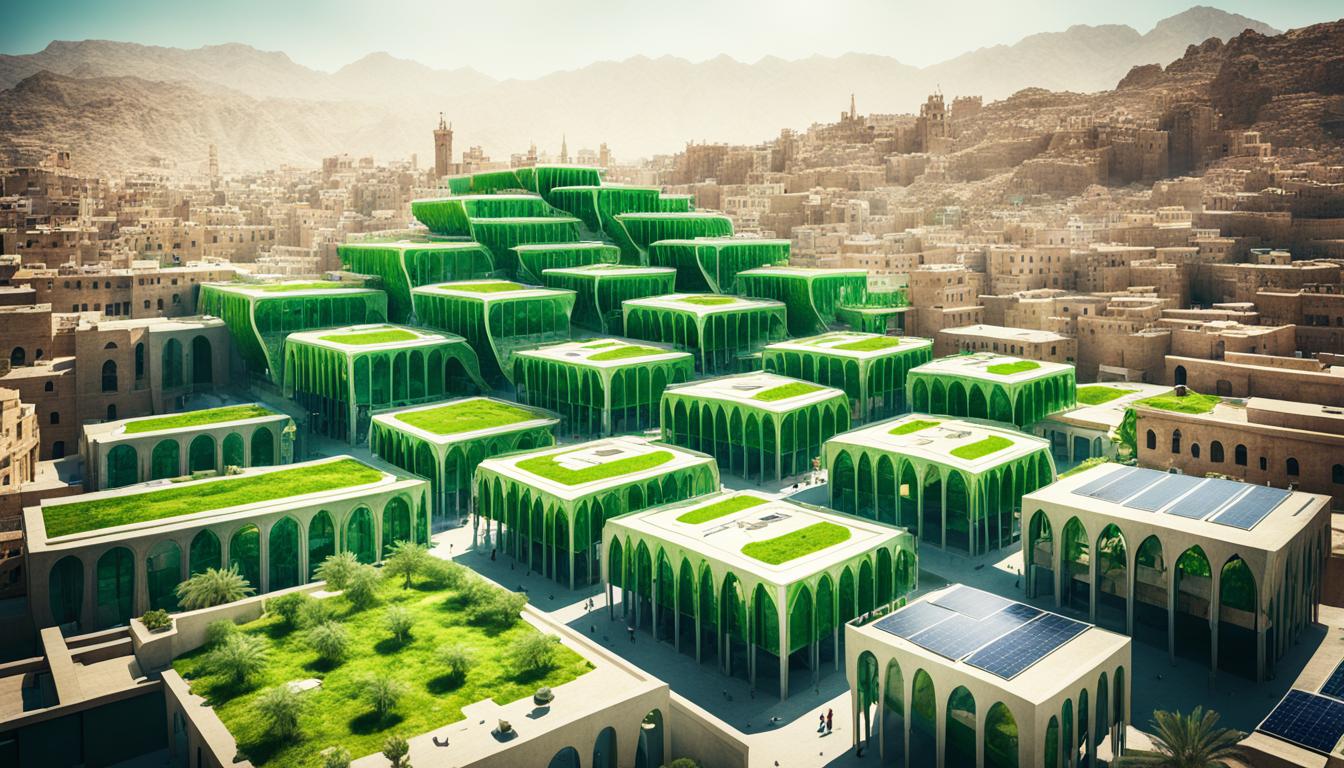Guatemala Green Building History
Guatemala has a rich history of green building practices, with a focus on sustainable construction and environmental initiatives. The country has shown a commitment to integrating eco-friendly design principles and promoting the use of sustainable building materials, minimizing its impact on the environment. This dedication to green building has led to the emergence of various organizations and projects that are making a positive impact on both the local community and the planet.
Key Takeaways:
- Guatemala has a significant history of green building practices, emphasizing sustainable construction.
- The Hero School and Long Way Home are organizations in Guatemala that are transforming waste into infrastructure and empowering communities through green building projects.
- Condado Naranjo is a master-planned community in Guatemala City that prioritizes sustainability.
- Guatemala’s efforts in green building have led to the country’s first LEED certified Existing Community in Latin America.
- Through the integration of eco-friendly practices, Guatemala is contributing to sustainable development and environmental conservation.
Evolution of Sustainable Architecture in Guatemala
Over the years, Guatemala has witnessed the evolution of sustainable architecture, with a growing emphasis on eco-friendly design principles and sustainable development. Architects and builders in the country have embraced the concept of eco-friendly architecture, aiming to minimize the environmental impact of construction while creating functional and aesthetically pleasing structures.
One of the key aspects of sustainable architecture in Guatemala is the integration of green building practices. This includes the use of renewable energy sources, such as solar panels, to power buildings, and the implementation of energy-efficient systems to reduce consumption. Additionally, eco-friendly materials, such as recycled or locally sourced materials, are being utilized to minimize waste and carbon footprint.
Guatemala has also seen an increased focus on sustainable development, ensuring that construction projects have a positive impact on the environment and the local communities. This includes the incorporation of green spaces and the preservation of natural habitats within urban developments. By prioritizing sustainability, Guatemala is paving the way for a greener future.

| Organization | Projects |
|---|---|
| Hero School | Water tanks, energy-efficient stoves, compost latrines, retaining walls |
| Long Way Home | Schools, homes, clinics made from recycled materials |
| Condado Naranjo | Solar panels, water efficiency measures, recycling promotion |
Conservation and Sustainable Building Materials in Guatemalan Construction
Conservation plays a vital role in Guatemalan construction, with a strong focus on using sustainable building materials that promote environmental stewardship. The country recognizes the importance of preserving its natural resources and reducing the ecological footprint of its construction industry. Architects and builders in Guatemala are increasingly adopting eco-friendly practices and incorporating sustainable materials into their projects.
One example of sustainable construction in Guatemala is the Hero School, which integrates green building projects into its educational curriculum. Through the construction of water tanks, energy-efficient stoves, compost latrines, and retaining walls, the Hero School empowers its students to be change makers and demonstrates the positive impact of sustainable building on both the environment and the local community.
Another organization making a difference is Long Way Home, which transforms waste into vital infrastructure. By using recycled materials, they have built schools, homes, and clinics, reducing the amount of rubbish that ends up in landfills. This innovative approach to sustainable construction not only provides much-needed infrastructure but also helps to address the waste management challenges faced by many communities in Guatemala.
In Guatemala City, the master-planned community of Condado Naranjo exemplifies sustainable development. With their installation of solar panels for energy production, implementation of water efficiency measures, and promotion of recycling, Condado Naranjo has become the first LEED certified Existing Community in Latin America. Their commitment to sustainability sets an example for future construction projects and demonstrates the potential for environmentally conscious living in urban areas.
By prioritizing conservation and using sustainable building materials, Guatemala is leading the way in green building practices. The efforts of organizations like the Hero School, Long Way Home, and Condado Naranjo showcase the positive impact that sustainable construction can have on the environment, the local community, and the future of Guatemala’s built environment.
Image:

| Sustainable Building Materials | Benefits |
|---|---|
| Bamboo | Renewable, fast-growing, high strength |
| Rammed Earth | Energy-efficient, thermal mass properties |
| Eco-friendly Concrete | Recycled materials, lower carbon footprint |
| Straw Bales | Insulation, renewable, biodegradable |
| Recycled Plastic | Durable, reduces plastic waste |
Hero School: Empowering Change through Green Building
The Hero School in Guatemala is a shining example of green building practices, empowering students to become change makers through sustainable construction projects. The school integrates environmental education with hands-on projects, allowing students to apply their knowledge to real-world scenarios. Through their initiatives, the Hero School has made a significant impact on the environment and the local community.
One of the key accomplishments of the Hero School is the construction of various sustainable solutions that benefit the community. These include water tanks, energy-efficient stoves, compost latrines, and retaining walls. These projects have not only improved the quality of life for community members but also minimized resource consumption and waste generation.
“The Hero School is committed to teaching students the importance of sustainability and environmental stewardship. Through our green building projects, we aim to inspire the next generation to actively contribute to a healthier and more sustainable future,” said Maria Sanchez, founder of the Hero School.
Another organization, Long Way Home, has also played a significant role in promoting sustainable construction in Guatemala. They have transformed over 1,000 tons of rubbish into vital infrastructure, such as schools, homes, and clinics, using recycled materials. This innovative approach not only reduces pollution but also addresses the issue of waste management in a resource-constrained environment.

Furthermore, Condado Naranjo, a master-planned community in Guatemala City, has set an example by prioritizing environmental initiatives and green building practices. They have installed solar panels for energy production, implemented water efficiency measures, and promote recycling. As a result, Condado Naranjo has become the first LEED certified Existing Community in Latin America, demonstrating the community’s commitment to sustainability.
In Summary
The Hero School, Long Way Home, and Condado Naranjo are just a few examples of the green building practices in Guatemala. These organizations showcase the country’s dedication to sustainable construction and its positive impact on both the environment and the community. Through their efforts, they are inspiring change and paving the way for a greener future.
Long Way Home: Turning Rubbish into Infrastructure
Long Way Home has been instrumental in Guatemala’s sustainable construction efforts, creatively turning tonnes of waste into essential infrastructure. This innovative organization has transformed over 1,000 tons of rubbish into vital structures such as schools, homes, and clinics, using recycled materials.
One of their notable projects is the Escuela Modelo, a primary school constructed entirely from recycled materials. The school showcases the possibilities of eco-friendly architecture in Guatemala and serves as an inspiration for sustainable construction practices.
Long Way Home’s commitment to sustainable development goes beyond the construction of buildings. The organization also focuses on education and community involvement, empowering local residents with knowledge and skills for environmentally conscious living. They conduct workshops on waste management and promote recycling initiatives in the surrounding communities.
The efforts of Long Way Home are not only beneficial to the environment but also have a positive social impact. By repurposing waste materials, they reduce the strain on natural resources and provide valuable infrastructure to underserved communities, improving their quality of life.

| Projects | Materials | Impact |
|---|---|---|
| Escuela Modelo | Recycled bottles, tires, and plastic | Provides an environmentally friendly educational facility |
| Community Buildings | Recycled pallets, plastic, and metal | Creates essential infrastructure for communities |
| Waste Management Workshops | N/A | Raises awareness about recycling and waste reduction |
“We believe that by turning trash into treasure, we can create a more sustainable and equitable future for Guatemala.” – Long Way Home
Summary:
Long Way Home has been at the forefront of Guatemala’s sustainable construction movement, leveraging innovative approaches to transform waste into vital infrastructure. Through their projects, such as the construction of the Escuela Modelo, Long Way Home demonstrates the potential of eco-friendly architecture in Guatemala. Additionally, their focus on education and community involvement fosters long-term sustainability and empowers local residents to adopt environmentally conscious practices.
Condado Naranjo: A Sustainable Master-Planned Community
Condado Naranjo stands as a prime example of a sustainable master-planned community in Guatemala, leading the way with its environmental initiatives and commitment to green building practices. This community’s dedication to sustainability can be seen through various initiatives that prioritize conserving resources, reducing waste, and promoting eco-friendly living.
- Water Efficiency: Condado Naranjo has implemented water-saving measures such as rainwater harvesting and greywater recycling systems. These initiatives ensure efficient water usage throughout the community, minimizing water waste and promoting responsible water management.
- Solar Energy: The community has also embraced solar energy as a sustainable alternative to traditional power sources. Solar panels are installed throughout the community to generate clean and renewable energy, reducing reliance on fossil fuels and decreasing greenhouse gas emissions.
In addition to these environmental initiatives, Condado Naranjo promotes recycling and waste reduction through designated recycling centers and composting programs. By encouraging residents to adopt sustainable practices, the community creates a culture of environmental responsibility and awareness.
The Benefits of Living in Condado Naranjo
“Living in Condado Naranjo allows us to make a positive impact on the environment while enjoying a high quality of life. The community’s sustainable practices not only reduce our carbon footprint but also contribute to a healthier and more sustainable future for all.”
Residents of Condado Naranjo enjoy a range of benefits resulting from its commitment to green building practices. These include improved air and water quality, reduced energy costs, and a strong sense of community and pride in living in a sustainable environment.
With its holistic approach to sustainability, Condado Naranjo has achieved recognition as the first LEED certified Existing Community in Latin America. The community serves as an inspiration for other developments in Guatemala and beyond, proving that environmentally conscious living is both attainable and rewarding.

| Key Features of Condado Naranjo | Benefits |
|---|---|
| Water-saving measures | Efficient water usage and responsible water management |
| Solar energy | Clean and renewable energy, reduced reliance on fossil fuels |
| Recycling and waste reduction | Promotes a culture of environmental responsibility and awareness |
Conclusion
In conclusion, Guatemala’s green building history reflects a strong commitment to sustainable construction, with various initiatives and organizations leading the way towards a greener future.
The Hero School in Guatemala is truly a hero for the environment and the community. Through their integration of green building projects, they empower students to be change makers while constructing sustainable solutions such as water tanks, energy-efficient stoves, compost latrines, and retaining walls. With these initiatives, they have positively impacted the lives of over 500 community members.
Long Way Home, another organization in Guatemala, has made significant contributions to sustainable construction. Through their innovative approach, they have transformed over 1,000 tons of rubbish into vital infrastructure, including schools, homes, and clinics. By utilizing recycled materials, Long Way Home not only reduces waste but also promotes eco-friendly architecture in the country.
Additionally, Condado Naranjo, a master-planned community in Guatemala City, sets an example for environmentally conscious development. Through the installation of solar panels for energy production, implementation of water efficiency measures, and promotion of recycling, Condado Naranjo has become the first LEED certified Existing Community in Latin America. Their efforts demonstrate the potential for sustainable community planning and green building practices in Guatemala.
FAQ
What is the history of green building in Guatemala?
Green building in Guatemala has a rich history, with organizations like the Hero School and Long Way Home leading the way in sustainable construction. These initiatives have empowered communities and created environmentally friendly infrastructure.
How has sustainable architecture evolved in Guatemala?
Sustainable architecture in Guatemala has evolved over the years, with a focus on eco-friendly design principles and the integration of green building practices. This approach has helped reduce environmental impact and promote sustainable development.
What role does conservation play in Guatemalan construction?
Conservation is a central aspect of Guatemalan construction, with an emphasis on using sustainable building materials and practices that minimize environmental impact. This approach ensures long-term sustainability and protection of natural resources.
What is the Hero School and how does it contribute to green building in Guatemala?
The Hero School in Guatemala is an educational institution that integrates green building projects into their curriculum. They empower students to be change makers by constructing sustainable solutions like water tanks, energy-efficient stoves, compost latrines, and retaining walls, benefiting both the environment and the community.
How does Long Way Home promote sustainable construction in Guatemala?
Long Way Home is an organization in Guatemala that transforms waste into vital infrastructure, such as schools, homes, and clinics, using recycled materials. Their innovative approach promotes sustainable construction and fosters eco-friendly architecture in the country.
What is Condado Naranjo and how does it promote sustainability in Guatemala?
Condado Naranjo is a master-planned community in Guatemala City that prioritizes sustainability. They have installed solar panels for energy production, implemented water efficiency measures, and promote recycling. Their efforts have led to them becoming the first LEED certified Existing Community in Latin America, setting an example for green building practices in the region.







